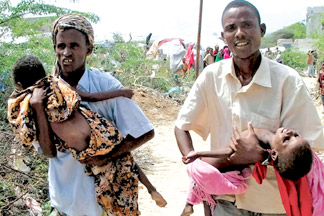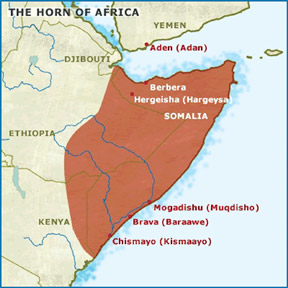Millions affected by famine
The effects of global warming are raising its ugly head in many parts
of the world today with certain parts of Africa and America experiencing
severe drought conditions. The worst case scenario is reported from
Africa. Many of you may have seen or heard of the severe hardships faced
by millions of people in the Horn of Africa due to a famine; the result
of a severe drought in the region
 Those
who are most affected are the children and UNICEF reports claim
thatmillions of children will die if urgent measures are not taken to
bring aid to them in the form of food and water. To those of us who have
plenty to eat and fresh water to drink at the turn of a tap, the impact
of a severe drought and famine and the suffering of those affected by
it, may be hard to even imagine. But, this is an eye opener to all of us
to not waste food and water and also be more aware of the environmental
impacts of our careless actions.It is time we realised that the entire
world is running the risk of facing a famine unless we change our course
of actions now and become more responsible citizens of the world. Those
who are most affected are the children and UNICEF reports claim
thatmillions of children will die if urgent measures are not taken to
bring aid to them in the form of food and water. To those of us who have
plenty to eat and fresh water to drink at the turn of a tap, the impact
of a severe drought and famine and the suffering of those affected by
it, may be hard to even imagine. But, this is an eye opener to all of us
to not waste food and water and also be more aware of the environmental
impacts of our careless actions.It is time we realised that the entire
world is running the risk of facing a famine unless we change our course
of actions now and become more responsible citizens of the world.
Let' s check out some facts about the current situation in the Horn
of Africa .
The famine as we explained before is a result of a severe drought
said to be "the worst in 60 years",that affected the entire Eastern
Africa region. Lack of water to cultivate impacted the food stocks and
it has caused a severe food crisis across Somalia, Ethiopia and Kenya.
The livelihood of more than 10 million people are under threat at the
moment. The food crisis is not limited to the Horn of Africa.
Even other countries in and around the Horn of Africa such as
Djibouti, Sudan, South Sudan and parts of Uganda, are also affected by a
food crisis
 The
U.N. declared a famine in Somalia's southern Bakool and Lower Shabelle
regions. The agency launched its largest ever relief effort to help
those affected.The famine will spread to all eight provinces of Somalia
if no immediate action is taken according to the officials. The
U.N. declared a famine in Somalia's southern Bakool and Lower Shabelle
regions. The agency launched its largest ever relief effort to help
those affected.The famine will spread to all eight provinces of Somalia
if no immediate action is taken according to the officials.
The famine was declared in response to new data from U.N's food
security and nutrition analysis unit, which showed that the situation in
southern Somalia now meets all three characteristics of widespread
famine: 1) more than 30 per cent of children suffering from acute
malnutrition; 2) more than two adults or four children dying of hunger
each day for every group of 10,000 people; and 3) the population having
access to less than 2,100 kilo calories of food and four litres of water
per day.
The crisis is getting worse by the day and appeals are made to the
world at large to step in and help save those affected by this
crisis.Humans as well as animals are suffering greatly without a morsel
of food to eat and a drop of water to drink; their agonised cries are
heart wrenching. So,think twice before you fuss about the food you have
to eat and waste food or pollute water resources.
Millions,including children like you are paying with their dear life
because of the manner in which we destroy the environment and waste its
precious resources. Life is precious and we are all responsible for what
is happening around the world today. Act with more responsibility to
avoid the crisis in the Horn of Africa from spreading to the rest of the
world in the future.
Fact file
* In early July, the Famine Early
Warning Systems Network (FEWS-Net) declared an emergency for large areas
in southern Somalia, south eastern Ethiopia, and north eastern Kenya,
which could culminate in widespread famine if the current conditions are
not addressed.
* On July 20, the United Nations
officially declared a famine in several parts of southern Somalia, the
first time a famine has been declared since the 1984-1985 famine in
Ethiopia, when over a million people died.
 *
Weather conditions over the Pacific, including an unusually strong La
Nina have interrupted seasonal rains for two consecutive seasons. The
rains failed this year in Kenya and Ethiopia, and for the last two years
in Somalia.Rains are not expected to return until September 2011 *
Weather conditions over the Pacific, including an unusually strong La
Nina have interrupted seasonal rains for two consecutive seasons. The
rains failed this year in Kenya and Ethiopia, and for the last two years
in Somalia.Rains are not expected to return until September 2011
* Large numbers of people from Somalia
have fled to neighbouring countries, in particular Kenya and Ethiopia.
The three refugee camps in Dadaab, Kenya currently host at least 440,000
people, though its maximum capacity is limited at 90,000.
* Within the camps, infant mortality has
risen threefold in the last few months, according to the United Nations.
The overall mortality rate is 7 out of 10,000 per day, which is more
than thrice as high as a "normal crisis rate".
* Save the Children has reported that
malnutrition rates among children in Kenya and Somalia have reached 30
per cent in some areas.
* The World Health Organization stated
that "8.8 million people are at risk of malaria and 5 million of
cholera" in Ethopia, due to crowded, unsanitary conditions.
* According to World Vision
International, families are agreeing to give their daughters as young as
13 in arranged marriages just to earn money from the dowry so that they
can purchase food.
* The World Food Programme (WFP), which
is trying to feed 1.5m people, estimates that as many as 1 million
people are in areas it cannot currently access.
* UN humanitarian agencies have
requested US$ 1.6 billion to address the crisis, but so far secured only
half that amount.
Facts and pix:Internet
|

